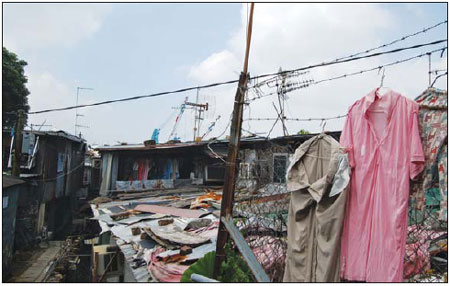Shantytowns face hard home truths
Waiting game
A watershed for Hong Kong's shanties came in 1982 when the regional government conducted a survey of all existing squatter structures, the materials that went into them and the surrounding neighborhoods.
 |
|
A corner of Cha Kwo Ling in eastern Kowloon that is home to 3,000 people. The area has long been a major settlement for the Hakka ethnic group and mainland migrants. |
No new shanties have been permitted since then but dwellings built prior to that are tolerated until redevelopment begins.
Qualified residents of shantytowns have been told they will be re-housed in public rental apartments; however, such properties are in short supply.
Almost one-third of Hong Kong's 7 million residents live in its 710,000 public rental homes, according to official statistics.
In his annual policy address last month, Donald Tsang, chief executive of the SAR, vowed that the government will shorten the average waiting time for a public accommodation to three years by allocating enough land for 15,000 new apartments every year.
Ip said the government has so far "ceased its large-scale eastbound development in New Kowloon, which started in the 1930s and lasted for half a century". (Cha Kwo Ling lies to the far east of New Kowloon.)
If the government does redevelop Tse's village, residents would be given two years' credit by the housing authority, which would theoretically slash the waiting time to about 12 months. However, not everyone will be eligible.
"To qualify, at least half of an applicant's family must have lived in Hong Kong for seven years," said Ng Yin-cham of the Neighborhood Advice Action Council, a government-backed organization offering consultancy services to the "most helpless people".
"A considerable number of dwellers are migrants from the Chinese mainland," he said. "Their wives and children may have come to Hong Kong later and have not been here for seven years."
Tse has lived in Hong Kong for decades but most of her children and grandchildren are now in Guangzhou, capital of South China's Guangdong province.
In fact, the 65-year-old said that, despite the hardships, she does not want to move from the community she has laid down her roots.
"My house is cozy, and I pass the time of day with my neighbors," she said, smiling. "In a public housing estate, the doors are all shut. People don't even know each other."
Every afternoon, locals flow into Tse's cafe for snacks, drinks and conversation. Inside are six wooden tables fixed to the floors, while among the decoration is an old, yellowed advertisement poster.
The shantytown offers more than just a relaxed ambience, though. "The location is ideal: sitting on a hill and facing the sea," said Tse. "Transportation is also convenient."
 0
0 






